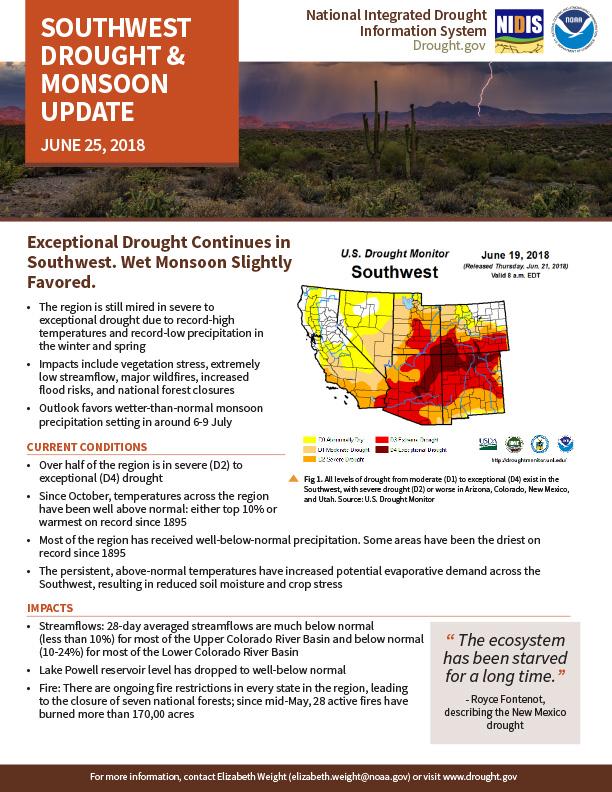Southwest Drought & Monsoon Update - June 25, 2018
Exceptional Drought Continues in Southwest. Wet Monsoon Slightly Favored.
- The region is still mired in severe to exceptional drought due to record-high temperatures and record-low precipitation in the winter and spring
- Impacts include vegetation stress, extremely low streamflow, major wildfires, increased flood risks, and national forest closures
- Outlook favors wetter-than-normal monsoon precipitation setting in around 6-9 July
CURRENT CONDITIONS
- Over half of the region is in severe (D2) to exceptional (D4) drought
- Since October, temperatures across the region have been well above normal: either top 10% or warmest on record since 1895
- Most of the region has received well-below-normal precipitation. Some areas have been the driest on record since 1895
- The persistent, above-normal temperatures have increased potential evaporative demand across the Southwest, resulting in reduced soil moisture and crop stress
IMPACTS
- Streamflows: 28-day averaged streamflows are much below normal (less than 10%) for most of the Upper Colorado River Basin and below normal (10-24%) for most of the Lower Colorado River Basin
- Lake Powell reservoir level has dropped to well-below normal
- Fire: There are ongoing fire restrictions in every state in the region, leading to the closure of seven national forests; since mid-May, 28 active fires have burned more than 170,00 acres
OUTLOOK
- Temperatures July to September: Increased possibility of above-average temperatures
- Monsoon: The Monsoon pattern is likely to set in by July 6-9, with a slight favoring of a wetter-than-normal monsoon period from July through September. These months are key: a significant portion of the region’s annual precipitation falls in this timeframe, so a wetter-than-normal monsoon could improve the drought. Conversely, areas burned by wildfire could see an increased risk of flash flooding with monsoon rains.
Special Thanks
This webinar was presented by Becky Bolinger, Colorado Assistant State Climatologist, and Brian Klimowski, Meteorologist-in-Charge at NWS Flagstaff.
Next Update
The next Southwest Drought Status Update will be on July 25. Speakers include: Nancy Selover, Arizona State Climatologist, and Ed Delgado, National Interagency Fire Center, Predictive Services Manager. Contact Elizabeth Weight for more information.


